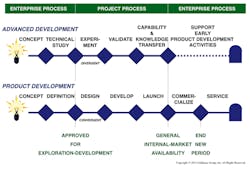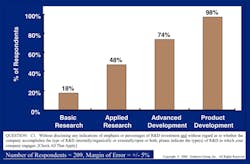Only a few industries — such as pharmaceutical, biotech, chemical, and semiconductor — have routinely and necessarily focused on underserved markets instead of underserved customers. These industries operate on the philosophy of “build it and they will come.” As such, they have invested in the preproduct development activities of basic research, applied research, and advanced development to a much larger extent.
In the late 1990s, the pendulum began to swing. Globalization had put great pressure on profit margins. Markets began to be shared by more companies, and more competitors began appearing regularly. The tech upstarts and resultant boom of the late 1990s had given industry a taste for the profits and prestige that “new” products could bring. It is no wonder the 2000s spawned a focus on innovation. What company doesn’t want higher brand value and market share, a higher stock price, and growing revenues with higher profits, not to mention the pride their engineers and designers feel when customers worship their products?
Of course, companies are more interested in profits than in the self-esteem of their engineers and product developers. So after the tech boom, market-leading companies increased investments and formalized their advanced processes. Now, a decade later, that process is beginning to permeate just about all industries. Advanced development is the current rage, and it will eventually lead to more applied research.
What is advanced development? Well, there are several definitions. Some companies use it to turn out finished designs that go right to manufacturing. Others have it wrestle down hard-to-achieve features and commercialize unfamiliar or unpredictable technologies. And some companies also throw stretch products into advanced development to get them to the marketplace. No one knows the best definition yet.
If the goals are systematic “new-to-X” innovation, advanced development should not be the place to do turnkey products. Company mangers already argue over whether design engineering is overloaded or if pouring resources into sustaining engineering reduces the capacity for new products or vice versa. Why, then, would one push this upstream even further to where stretch bets are taken? It won’t be long before management decides to do less-challenging projects and an occasional sustaining-engineering turnkey project while making short term trade-off decisions during busy times. The skill sets of AD engineers are necessarily deeper than they are broad in companies that want to accomplish new-to-X. Generalists rarely do competitive-advantage engineering, and commercial products are rarely designed by specialists.
Advanced development is now practiced by three-quarters of all companies to some degree. New research will soon update this figure. AD strategy is a large subject, but its workflow should be analogous to product development. Recognizing that AD engineers will have consultative roles, the goal of AD resources should be to release commercialization-ready capabilities, technologies, features, and functions to portfolio managers and product developers. Necessarily, some AD will trace back to customer and market requests while some will be leveraged to build something truly innovative, and the customers will come. As best practices sort themselves out, AD is sure to be an exciting place for its engineering and technical professionals.
Bradford L. Goldense, NPDP, CMfgE, CPIM, CCP, president of Goldense Group Inc. (GGI), has advised over 300 manufacturing companies in product management, R&D, engineering, product development, and metrics on four continents. GGI is a consulting, market research, and executive education firm founded in 1986.
Subsequent writings in this column will expand on the lessons-learned of where
we have been, and will offer views on what the future holds for product design.



